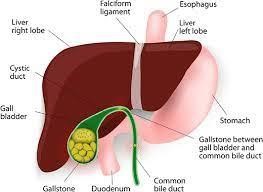A nurse is preparing to administer PRN pain medication to a client who has cholelithiasis and is experiencing moderate abdominal pain. Which of the following medications should the nurse plan to administer?
Acetaminophen
Omeprazole
Metoclopramide
Ketorolac
The Correct Answer is A
Choice A reason:
Acetaminophen is a safer choice for pain relief in clients with cholelithiasis because it does not have significant effects on the gallbladder or biliary system. It can provide effective pain relief without exacerbating the underlying condition.
Choice B reason:
Omeprazole Omeprazole should not administer because it is a proton pump inhibitor (PPI) used to reduce stomach acid production and treat conditions such as gastroesophageal reflux disease (GERD) and peptic ulcers. It is not indicated for the treatment of pain and discomfort associated with cholelithiasis.
Choice C reason
Should not be administered
Metoclopramide Metoclopramide should not be administered because it is a medication used to treat gastrointestinal issues such as nausea, vomiting, and gastroparesis. It is not indicated for the treatment of pain associated with cholelithiasis.
Choice D reason:
Ketorolac Ketorolac should not be administered because it is an NSAID used for moderate to severe pain. However, it should be avoided in clients with cholelithiasis due to its potential adverse effects on the gallbladder and biliary system.

Nursing Test Bank
Naxlex Comprehensive Predictor Exams
Related Questions
Correct Answer is C
Explanation
Choice A reason:
"Repeat the dose if your child vomits within 1 hour after taking the medication." This statement is incorrect. If a child vomits within 1 hour after taking digoxin, the parents should not repeat the dose. The reason is that the child may have already absorbed a sufficient amount of the medication before vomiting, and an additional dose could lead to digoxin toxicity.
Choice B reason:
"You can add the medication to a half-cup of your child's favourite juice." This statement is incorrect. Adding digoxin to juice or any other food or drink is not recommended. Digoxin should be administered separately and not mixed with food or liquids to ensure accurate dosing and prevent potential interactions with other substances.
Choice C reason:
"Have your child drink a small glass of water after swallowing the medication." This statement is correct. Giving a small glass of water after administering digoxin helps ensure that the medication is fully swallowed and goes into the stomach, reducing the risk of it being retained in the mouth or throat.
Choice D reason:
"Limit your child's potassium intake while she is taking this medication." This statement is not accurate. Digoxin is often prescribed in conjunction with other heart failure medications, some of which may impact potassium levels. However, the parents should not arbitrarily limit the child's potassium intake without specific instructions from the healthcare provider. The healthcare provider will monitor the child's potassium levels and adjust the treatment plan as necessary.
Correct Answer is C
Explanation
A. Incorrect. HD does not affect the eyes.
B. Incorrect. HD does not affect the respiratory system or cause chest manifestations.
C. Correct. Hirschsprung disease (HD) is a congenital disorder that affects the nerve cells in the colon, causing a lack of peristalsis and bowel obstruction. Infants with HD may have a distended abdomen due to fecal accumulation and gas.
Whether you are a student looking to ace your exams or a practicing nurse seeking to enhance your expertise , our nursing education contents will empower you with the confidence and competence to make a difference in the lives of patients and become a respected leader in the healthcare field.
Visit Naxlex, invest in your future and unlock endless possibilities with our unparalleled nursing education contents today
Report Wrong Answer on the Current Question
Do you disagree with the answer? If yes, what is your expected answer? Explain.
Kindly be descriptive with the issue you are facing.
